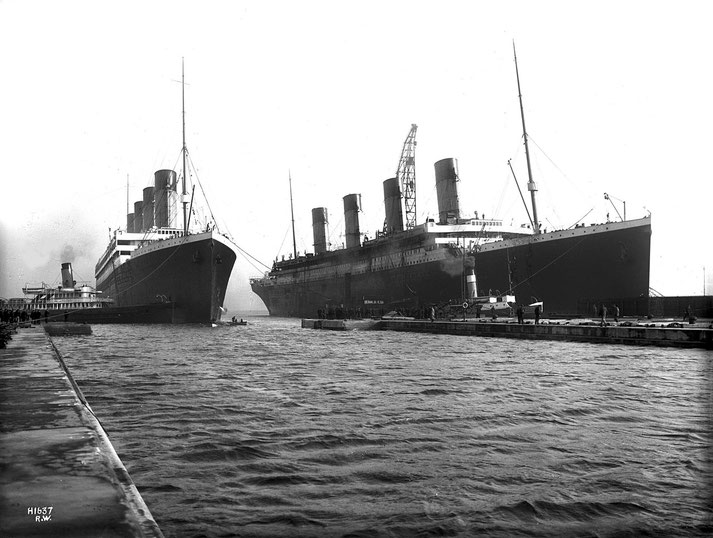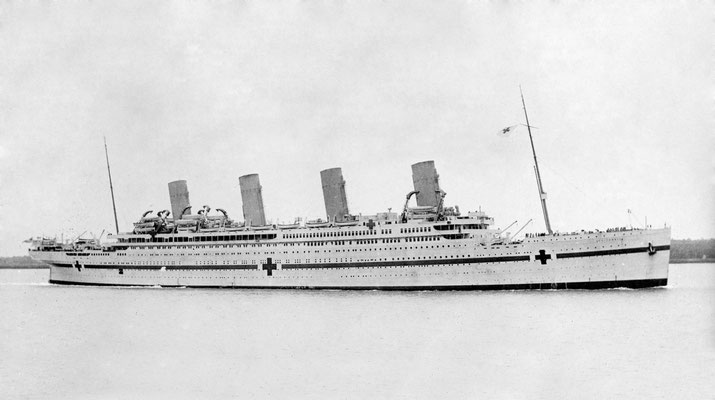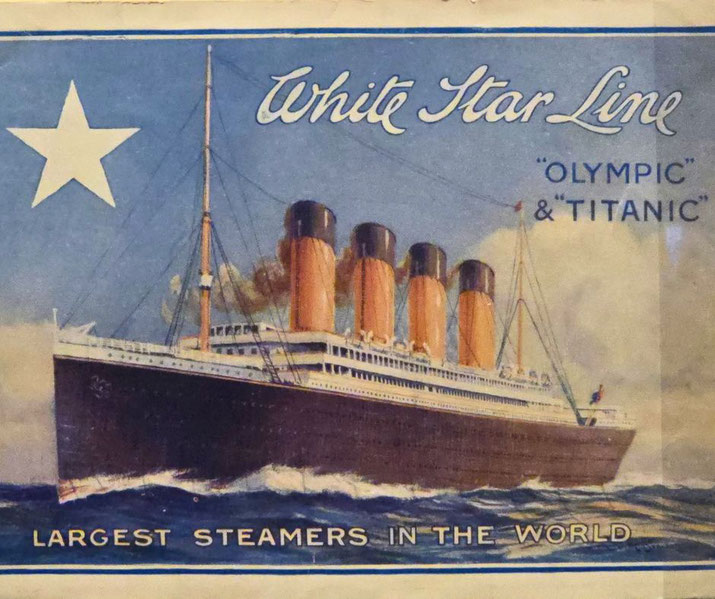Two other Titanic ships were built and had tragic endings as well

You've probably heard of the Titanic, which is the most famous shipwreck in history. But did you know that the Titanic had two sister ships of almost the same size and shape?
These three ships were part of the White Star Line's Olympic‑class liners, which were designed to be the biggest, most luxurious, and safest ships of their time.
Here, we'll look at the interesting stories of the Britannic and the Olympic, how they differed from the Titanic, and what happened to them after their first voyages.
What were the 'Olympic Class' ships?
The Olympic‑class ships were a trio of British ocean liners built by the Harland & Wolff shipyard in Belfast, Northern Ireland, for the White Star Line during the early 1900s.
They were named the Olympic (1911), Titanic (1912), and Britannic (1914).
The White Star Line was owned by the International Mercantile Marine Company.
Key to funding the construction of the Olympic‑class liners, American financier J. P. Morgan controlled the company.
All three liners were built by Thomas Andrews, the chief designer at Harland & Wolff, to be the largest and most luxurious passenger ships of that era.
White Star Line chairman J. Bruce Ismay ordered them to give his company an edge in the transatlantic passenger trade.
The most famous of the three, the Titanic, was actually the second built. She was launched on 31 May 1911 and entered service in April 1912.
People called the Titanic unsinkable, but she hit an iceberg and sank on her first trip from Southampton to New York killing more than 1,500 of the 2,224 people on board.
It remains one of the worst and most famous maritime disasters ever. The other two ships, less well known, had both successes and setbacks during their careers.
What happened to the RMS Olympic?
The Olympic was the first of the three sister ships to be built and was launched on 20 October 1910.
She made her first trip on 14 June 1911 from Southampton to New York and had a long career as a passenger ship which carried celebrities, politicians, and wealthy travellers across the Atlantic.
The Olympic was the largest ship in the world until her sister ship Titanic surpassed her in gross tonnage in 1912.
She also served as a troopship during World War I and earned the nickname "Old Reliable" for her toughness.
During the Gallipoli Campaign in 1915, she took soldiers to the fighting in the Dardanelles.
The Olympic survived several incidents, including a crash with a British warship in 1911.
During World War I, Olympic dodged a torpedo from a German U‑boat, then famously rammed and sank U‑103, which made her one of the few ships to sink a submarine during the war.
She went through several refits over the years and was kitted out with oil‑fired boilers and new propellers.
After the Titanic disaster, new rules required all passenger ships to carry enough lifeboats for everyone.
As a result, extra lifeboats were added to both the Olympic and the Britannic.

The Olympic continued to operate as a passenger ship after World War I, but faced increasing competition from newer and faster liners, such as the Cunard Line's Queen Mary and Queen Elizabeth.
She also suffered from the decline in demand for trans‑Atlantic travel due to the Great Depression and the rise of air travel.
In 1934, the White Star Line merged with the Cunard Line, and the Olympic became part of the new Cunard‑White Star Line.
That same year, the Olympic was involved in a tragic collision with the Nantucket Lightship LV‑117 on 15 May.
Heavy fog and navigation errors caused the accident.
The Olympic was following the lightship's radio signal and came out of the fog too close to the smaller ship, unable to avoid impact.
Even at reduced speed, Olympic hit the lightship and cut it in half.
Sadly, seven of the lightship's eleven crew members died, four of them going down with the wreckage.
The Olympic picked up the survivors but continued her trip in a grim mood and she flew her flag at half‑mast.
She made her last voyage in March 1935, retiring in April 1935 after a long 24‑year career.
She was sold for scrap later that year and taken apart in Jarrow and Inverkeithing, England, between 1935 and 1937.
Parts of the ship, including her grand staircase and wood panelling, were sold and reused in various places, including a hotel in England.
Even though it was less dramatic than the endings of Titanic and Britannic, RMS Olympic's fate was still sad because she went from a celebrated ocean liner to an unceremonious scrapping.
Even with her long career, heroic wartime work, and surviving many accidents, her legacy would always be overshadowed by comparisons with the Titanic disaster.
What sank the HMHS Britannic?
The Britannic was the last of the three Olympic class ships and was also considerably modified to be safer than its sister ships after the Titanic sank in 1912.
Some of the changes included more lifeboats, higher watertight compartments, and lengthening the double hull sections.
However, the Britannic never served as a commercial vessel because it was completed after the outbreak of World War I in 1914.
The British government took over the Britannic as a hospital ship and it was renamed His Majesty's Hospital Ship, HMHS Britannic.
It was the largest hospital ship ever constructed with a gross tonnage of 48,158 tons.
The Britannic made five successful voyages to the Mediterranean that transported wounded soldiers from various battlefields to England.

On the 21st of November 1916, the Britannic was on its way to pick up more casualties from Greece when disaster hit near the island of Kea.
Initially, there was confusion about whether it had hit a mine or was hit by a torpedo.
Either way, the explosion damaged six of the watertight compartments and caused water to flood in through the open portholes.
Commanding Captain Charles Bartlett tried to beach the ship on Kea but it was too late. The Britannic sank in less than an hour taking 30 lives with it.
Surprisingly, despite the quick sinking of the Britannic, over 1,000 passengers and crew were saved from the disaster due to the prompt response of nearby rescue vessels and the lifeboat drills that had been held regularly on board.
Later examination confirmed that it had hit a mine, which was just two years after she had been completed and entered service.
The Britannic is still the largest passenger shipwreck in one piece in the world at a depth of about 400 feet (120 meters) in the Aegean Sea.
It was discovered by Jacques Cousteau in 1975 and has been explored by several expeditions since then.
Differences between the Olympic, Titanic and Britannic
The main differences between the three Olympic class ships were their size, design, and service.
Britannic was slightly larger than her sisters with a gross tonnage of 48,158 tons compared to 46,328 tons for Titanic and 45,324 tons for Olympic.
She also had a more powerful turbine engine and a larger rudder for better maneuverability.
In comparison, the Titanic had some minor design improvements over Olympic such as an enclosed promenade deck on A-deck.
Although, as mentioned earlier, the Olympic did have some modifications after Titanic's sinking, such as the lengthening of the double hull and additional lifeboats.
However, all three ships had different careers with the Olympic serving as a civilian liner for most of her life and the Britannic serving primarily as a hospital ship.
Remembering the Titanic's sister ships
So, while the Olympic and Britannic may not have had the same tragic end as their sister ship, the Titanic, they still had interesting and distinctive stories of their own.
The Olympic and Britannic may not be as famous as the Titanic but they are still worth remembering and exploring for their contributions to maritime history.

What do you need help with?
Download ready-to-use digital learning resources
Copyright © History Skills 2014-2025.
Contact via email
With the exception of links to external sites, some historical sources and extracts from specific publications, all content on this website is copyrighted by History Skills. This content may not be copied, republished or redistributed without written permission from the website creator. Please use the Contact page to obtain relevant permission.





